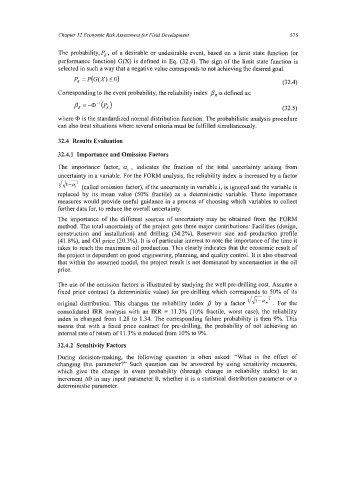Page 599 - Marine Structural Design
P. 599
Chapter 32 Economic Risk Assessment for Field Development 575
The probability, PE , of a desirable or undesirable event, based on a limit state function (or
performance function) G(X) is defined in Eq. (32.4). The sign of the limit state hction is
selected in such a way that a negative value corresponds to not achieving the desired goal.
PE = P(G(X) IO) (32.4)
Corresponding to the event probability, the reliability index ,8, is defined as:
p, = -W’(PJ
(32.5)
where @ is the standardized normal distribution function. The probabilistic analysis procedure
can also treat situations where several criteria must be fulfilled simultaneously.
32.4 Results Evaluation
32.4.1 Importance and Omission Factors
The importance factor, ai , indicates the fraction of the total uncertainty arising from
uncertainty in a variable. For the FORM analysis, the reliability index is increased by a factor
(called omission factor), if the uncertainty in variable i, is ignored and the variable is
replaced by its mean value (50% fractile) as a deterministic variable. These importance
measures would provide useful guidance in a process of choosing which variables to collect
further data for, to reduce the overall uncertainty.
The importance of the different sources of uncertainty may be obtained from the FORM
method. The total uncertainty of the project gets three major contributions: Facilities (design,
construction and installation) and drilling (34.2%), Reservoir size and production profile
(41.8%), and Oil price (20.3%). It is of particular interest to note the importance of the time it
takes to reach the maximum oil production. This clearly indicates that the economic result of
the project is dependent on good engineering, planning, and quality control. It is also observed
that within the assumed model, the project result is not dominated by uncertainties in the oil
price.
The use of the omission factors is illustrated by studying the well pre-drilling cost. Assume a
fixed price contract (a deterministic value) for pre-drilling which corresponds to 50% of its
original distribution. This changes the reliability index p by a factor For the
consolidated IRR analysis with an IRR = 11.3% (10% fi-actile, worst case), the reliability
index is changed from 1.28 to 1.34. The corresponding failure probability is then 9%. This
means that with a fixed price contract for pre-drilling, the probability of not achieving an
internal rate of return of 11.3% is reduced from 10% to 9%.
32.4.2 Sensitivity Factors
During decision-making, the following question is often asked “What is the effect of
changing this parameter?’ Such question can be answered by using sensitivity measures,
which give the change in event probability (through change in reliability index) to an
increment be in any input parameter 8, whether it is a statistical distribution parameter or a
deterministic parameter.

